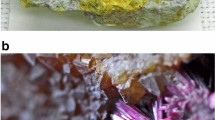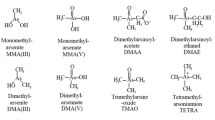Abstract
Arsenic, which is ubiquitous in the Earth’s crust, ranks 20th among the elements in abundance. Arsenic is widely but sparsely distributed in nature. Mostly the element is associated with igneous and sedimentary rocks, particularly with sulfidic ores. Arsenic enters aquatic environments indirectly from industrial and other air emissions, such as smelting operations and fossil-fuel combustion, and enters directly from localized effluent discharges.1
Access this chapter
Tax calculation will be finalised at checkout
Purchases are for personal use only
Preview
Unable to display preview. Download preview PDF.
Similar content being viewed by others
References
National Research Council ed. Arsenic: Medical and Biologic Effects of Environmental Pollutants. Washington, DC: National Academy of Sciences, 1977.
Maeda S. Safety and environmental effects. In: Patai S ed. The Chemistry of Organic Arsenic, Antimony, and Bismuth Compounds. New York: John Wiley & Sons, 1994: 725–759.
Clarke LB, Sloss LL. Sources of trace elements in the atmosphere. IEA Coal Research 1992; 49: 15–20.
Anke M, Schneider HJ, Bruckner C eds. Arsen: 3rd Spurenelement-Symposium. Jena: Friedrich-Schiller-University, 1980.
Lederer WH, Fensterheim RJ eds. Arsenic: Industrial, Biomedical, Environmental Perspectives. New York: Van Nostrand Reinhold, 1983.
Ishinishi N, Okabe S, Kikuchi T eds. Hiso: Kagaku, Taisha, Dokusei (Arsenic: Chemistry, Metabolism, and Toxicity). Tokyo: Koseisha-Koseikaku, 1985.
Irgolic KJ, Kikuchi T, Maeda S, Craig PJ, eds. Natural and Industrial Arsenic. Appl Organomet Chem 1988; 2: 283–404.
Irgolic KJ, Kikuchi T, Maeda S, Craig PJ, eds. Natural and Industrial Arsenic. Appl Organomet Chem 1990; 4: 181–295.
Maeda S, Craig PJ, eds. Natural and Industrial Arsenic. Appl Organomet Chem 1992; 6: 307–420.
Maeda S, Craig PJ, eds. Environmental and Industrial Arsenic. Appl Organomet Chem 1994; 8: 165–283.
Maeda S, Craig Pi, eds. Environmental and Industrial Arsenic. Appl Organomet Chem 1996; 10: 667–760.
Fowler BA, ed. Biological and Environmental Effects of Arsenic: Topics in Environmental Health. Amsterdam: Elsevier, 1983.
Nriagu JO, ed. Arsenic in the Environment. Part I: Cycling and Characterization. New York: John Wiley & Sons, Inc. 1994.
Nriagu JO ed. Arsenic in the Environment. Part II: Human Health and Ecosystem Effects, New York: John Wiley & Sons, Inc. 1994.
Brinckman FE, Bellama JM eds. Organometals and Organometalloids. Occurrence and Fate in the Environment. ACS Sym Ser Vol. 82. Washington DC; American Chemical Society, 1978.
Phillips, DJH, Depledge MH. Metabolic pathways involving arsenic in marine organisms: A unifying hypothesis. Mar Environ Res 1985; 17: 1–12.
Cullen WR, Reimer KJ. Arsenic speciation in the environment. Chem Rev 1989; 89: 713–764.
Phillips DJH. Arsenic in aquatic organisms: A review, emphasizing chemical speciation. Aqua Toxicol 1990; 16: 151–186.
Maeda S, Sakaguchi T. Accumulation and detoxification of toxic metal elements by algae. In: Akatsuka I ed. Introduction to Applied Psychology. The Hague: SPB Academic Publishing by, 1990: 109–136.
Lunde G. The synthesis of fat and water soluble arseno organic compounds in marine and limnetic algae. Acta Chem Scand 1973; 27: 1586–1594.
Lunde G. The analysis of arsenic in the lipid phase from marine and limnetic algae. Acta Chem Scand 1972; 26: 2642–2644.
Baker MD, Wong PTS, Chau YK et al. Methylation of arsenic by freshwater green algae. Can J Fish Aquat Sci 1983; 40: 1254–1257.
Nissen P, Benson AA. Arsenic metabolism in freshwater and terrestrial plants. Physiol Plant 1982; 54: 446–450.
Maeda S, Kumamoto, T, Yonemoto M et al. Bioaccumulation of arsenic by freshwater algae and the application to the removal of inorganic arsenic from an aqueous phase. Part I. Screening of freshwater algae having high resistance to inorganic arsenic. Sep Sci Tech 1983; 18: 375–385.
Maeda S, Nakashima S, Takeshita T et al. Bioaccumulation of arsenic by freshwater algae and the application to the removal of inorganic arsenic from an aqueous phase. Part II. By Chlorella vulgaris isolated from arsenic-polluted environment. Sep Sci Tech 1985; 20: 153–161.
Maeda S, Kumeda K, Maeda M et al. Bioaccumulation of arsenic by freshwater algae (Nostoc sp.) and the application to the removal of inorganic arsenic from an aqueous phase. Appl Organomet Chem 1987; 1: 363–370.
Maeda S, Fujita S, Ohki A et al. Takeshita T. Arsenic accumulation by arsenic-tolerant freshwater blue-green alga (Phormidium sp.). Appl Organomet Chem 1988; 2:353–357.
Maeda S, Kusadome K, Arima H et al. Uptake and excretion of total inorganic arsenic by the freshwater alga Chlorella vulgaris. Appl Organomet Chem 1992; 6: 399–405.
Maeda S, Ohki A, Naka K. Approach to commercial-scale removal of arsenic from environmental waters by freshwater algae accumulating and transforming arsenic. Rep Asahi Glass Found 1991; 58: 61–68.
Edmonds JS, Francesconi KA. Arseno-sugars from brown kelp (Ecklonia radiata) as intermediates in cycling of arsenic in a marine ecosystem. Nature (London) 1981; 289: 602–604.
Morita M, Shibata Y. Chemical form of arsenic in marine macroalgae. Appl Organomet Chem 1990; 4: 181–190.
Shibata Y, Jin K, Morita M. Arsenic compounds in the edible red alga, Porphyra tenera, and in nori and yakinori, food items produced from red algae. Appl Organomet Chem 1990; 4: 255–260.
Edmonds JS, Francesconi KA. Methylated arsenic from marine fauna. Nature (London) 1977; 265: 436.
Edmonds JS, Francesconi KA. The origin and chemical form of arsenic in the school whiting. Mar Pollut Bull 1981; 12: 92–96.
Edmonds JS, Francesconi KA. Isolation and identification of arsenobetaine from the American lobster Homarus americanus. Chemosphere 1981; 10: 1041–1044.
Edmonds JS, Francesconi KA. Trimethylarsine oxide in estuary catfish (Cnidoglanis macrocephalus) and school whiting (Sillago bassenis) after oral administration of sodium arsenate and as a natural component of estuary catfish. Sci Total Environ 1987; 64: 317–323.
Edmonds JS, Francesconi KA. The origin of arsenobetaine in marine animals. Appl Organomet Chem 1988; 2: 297–302.
Norin H, Christakopoulas A. Evidence for the presence of arsenobetaine and another organoarsenical in shrimp. Chemosphere 1982; 11: 287–298.
Norin H, Ryhage R, Christakopoulas A et al. New evidence for the presence of arsenocholine in shrimps (Pandalus borealis) by use of pyrolysis gas chromatography-atomic adsorption spectrometry/mass spectrometry. Chemosphere 1983; 12: 299–315.
Kaise T, Watanabe S, Ito K et al. The study of organoarsenic compounds in fish and alga by extract mass measurement using fast atom bombardment mass spectrometry. Chemosphere 1987; 16: 91–97.
Maeda S, Wada H, Kumeda K et al. Methylation of inorganic arsenic by arsenic-tolerant freshwater algae. Appl Organomet Chem 1987; 1: 465–472.
Maeda S, Kusadome K, Arima H et al. Biomethylation of arsenic and its excretion by the alga Chlorella vulgaris. Appl Organomet Chem 1992; 6: 407–413.
Maeda S, Ohki A, Miyahara K, et al. Metabolism of methylated arsenic compounds by arsenic-resistant bacteria (Klebsiella oxytoca and Xanthomonas sp.). Appl Organomet Chem 1992; 6: 415–420.
Maeda S, Arima H, Ohki A et al. The association mode of arsenic accumulated in the freshwater alga Chlorella vulgaris. Appl Organomet Chem 1992; 6: 393–397.
Maeda S, Mizoguchi M, Ohki A et al. Bioaccumulation of zinc and cadmium in freshwater alga, Chlorella vulgaris. Part II. Association mode of the metal and cell tissue. Chemosphere 1990; 21: 965–973.
Wrench J, Fowler SW, Unlii MY. Arsenic metabolism in a marine food chain. Mar Pollut Bull 1979; 10: 18–20.
Unlü MY. Chemical transformation and flux of different forms of arsenic in the crab Carcinus maenas. Chemosphere 1979; 5: 269–275.
Klumpp DW. Accumulation of arsenic from water and food by Littorina littorales and Nucella lapillus. Mar Biol 1980; 58: 265–274.
Klumpp DW, Peterson PJ. Chemical characteristics of arsenic in a marine food chain. Mar Biol 1981; 62: 297–305.
Cooney RV, Benson AA. Arsenic metabolism in Homarus americanus. Chemosphere 1980; 9: 335–341.
Andreae MO. Biotransformation of arsenic in the marine environment. In: Lederer WH, Fensterheim RJ, eds. Arsenic: Industrial, Biochemical, Environmental Perspectives. New York: Van Nostrand Reinhold, 1983: 378–392.
Isensee AR, Kearney PC, Woolson EA et al. Distribution of alkyl arsenicals in model ecosystem. Envir Sci Technol 1973; 7:841–845.
Maeda S, Ohki A, Tokuda T et al. Transformation of arsenic compounds in a freshwater food chain. Appl Organomet Chem 1990; 4251–254.
Maeda S, Inoue R, Kozono T et al. Arsenic metabolism in a freshwater food chain. Chemosphere 1990; 20: 101–108.
Maeda S, Fukuyama H, Yokoyama E et al. Bioaccumulation of antimony by Chlorella vulgaris and the association mode of antimony in the cell. Appl Organomet Chem 1997; 11: 393–396.
Luke CL, Campbell ME. Determination of impurities in germanium and silicon. Anal Chem 1953; 25: 1588–1594.
Maeda S, Ohki A. unpublished data.
Editor information
Editors and Affiliations
Rights and permissions
Copyright information
© 1998 Springer-Verlag Berlin Heidelberg
About this chapter
Cite this chapter
Maeda, S., Ohki, A. (1998). Bioaccumulation and Biotransformation of Arsenic, Antimony, and Bismuth Compounds by Freshwater Algae. In: Wong, YS., Tam, N.F.Y. (eds) Wastewater Treatment with Algae. Biotechnology Intelligence Unit. Springer, Berlin, Heidelberg. https://doi.org/10.1007/978-3-662-10863-5_5
Download citation
DOI: https://doi.org/10.1007/978-3-662-10863-5_5
Publisher Name: Springer, Berlin, Heidelberg
Print ISBN: 978-3-662-10865-9
Online ISBN: 978-3-662-10863-5
eBook Packages: Springer Book Archive




